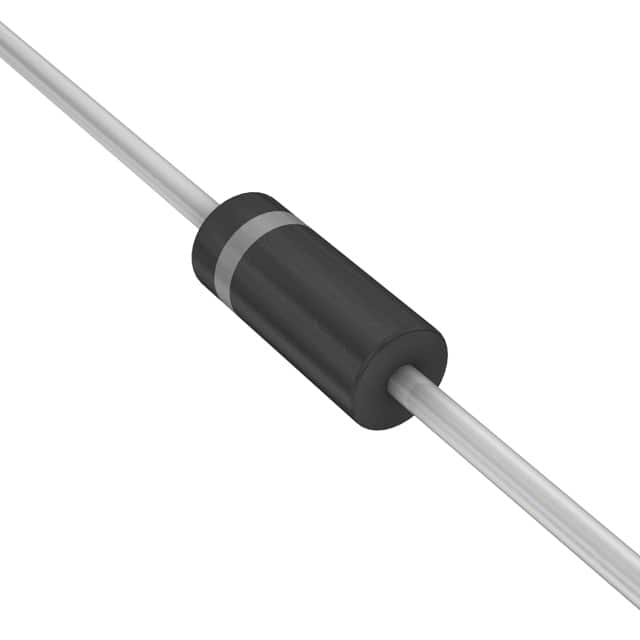Consulte las especificaciones para obtener detalles del producto.

1N5375BRL
Product Overview
Category:
The 1N5375BRL belongs to the category of semiconductor devices, specifically in the family of Zener diodes.
Use:
It is commonly used for voltage regulation and protection in electronic circuits.
Characteristics:
- Zener voltage: 75V
- Power dissipation: 5W
- Package type: Axial leaded
- Operating temperature range: -65°C to +200°C
- RoHS compliant
Package:
The 1N5375BRL is typically available in a DO-201AD package.
Packaging/Quantity:
It is often supplied in reels or bulk packaging, with quantities varying based on supplier and customer requirements.
Specifications
- Zener Voltage: 75V
- Power Dissipation: 5W
- Maximum Forward Voltage: 1.5V
- Maximum Reverse Current: 5μA
- Operating Temperature Range: -65°C to +200°C
Detailed Pin Configuration
The 1N5375BRL has a standard axial leaded package with two leads. The anode is connected to the positive terminal, while the cathode is connected to the negative terminal.
Functional Features
- Voltage regulation: The 1N5375BRL maintains a constant voltage across its terminals, making it suitable for stabilizing power supplies.
- Overvoltage protection: It can protect sensitive components in a circuit by diverting excess voltage away from them.
Advantages
- High power dissipation capability
- Wide operating temperature range
- RoHS compliant
Disadvantages
- Limited voltage options compared to other Zener diodes
- Relatively high reverse current compared to some alternatives
Working Principles
The 1N5375BRL operates based on the Zener effect, where it begins to conduct in the reverse direction once the voltage across its terminals reaches the specified Zener voltage. This allows it to regulate the voltage in a circuit.
Detailed Application Field Plans
The 1N5375BRL is commonly used in the following applications: - Voltage regulators - Overvoltage protection circuits - Power supplies - Electronic equipment requiring stable voltage levels
Detailed and Complete Alternative Models
Some alternative models to the 1N5375BRL include: - 1N5369BRL (Zener voltage: 47V, Power dissipation: 5W) - 1N5371BRL (Zener voltage: 51V, Power dissipation: 5W) - 1N5378BRL (Zener voltage: 82V, Power dissipation: 5W)
In conclusion, the 1N5375BRL Zener diode is a reliable component for voltage regulation and overvoltage protection in various electronic circuits, offering specific characteristics and functional features that cater to its intended applications.
Word count: 430
Enumere 10 preguntas y respuestas comunes relacionadas con la aplicación de 1N5375BRL en soluciones técnicas
What is the 1N5375BRL diode used for?
- The 1N5375BRL is a high-power, zener diode commonly used for voltage regulation and transient suppression in various technical solutions.
What is the maximum power dissipation of the 1N5375BRL?
- The maximum power dissipation of the 1N5375BRL is 50 watts.
What is the voltage rating of the 1N5375BRL?
- The 1N5375BRL has a voltage rating of 75 volts.
What are typical applications for the 1N5375BRL?
- Typical applications include voltage regulation in power supplies, surge protection in electronic circuits, and as a reference voltage source.
What is the operating temperature range of the 1N5375BRL?
- The 1N5375BRL operates within a temperature range of -65°C to +200°C.
What is the forward voltage drop of the 1N5375BRL?
- The forward voltage drop of the 1N5375BRL is typically 1.5V at 1A.
Is the 1N5375BRL suitable for automotive applications?
- Yes, the 1N5375BRL is suitable for automotive applications due to its high power handling and voltage regulation capabilities.
Can the 1N5375BRL be used for overvoltage protection?
- Yes, the 1N5375BRL can be used for overvoltage protection by shunting excess voltage to ground when the zener voltage is exceeded.
What is the reverse leakage current of the 1N5375BRL?
- The reverse leakage current is typically low, around 5µA at the zener voltage.
Are there any specific considerations for PCB layout when using the 1N5375BRL?
- It's important to ensure proper heat sinking and adequate trace widths to handle the high power dissipation of the 1N5375BRL.

